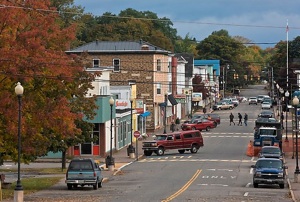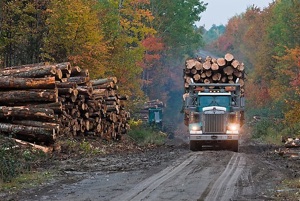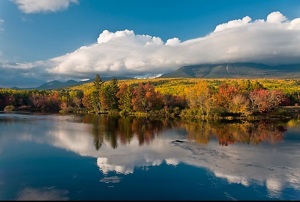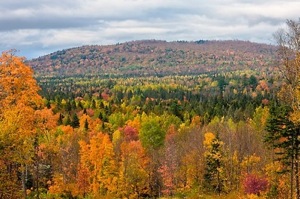Twenty years before the first national park, and more than a century before the Wilderness Act, (Henry David Thoreau) asked, "Why should not we ...have our national preserves, where ... the bear and pather ... may still exist, and not be 'civilized' off the face of the earth?" The Maine of his bark-canoe trips was the deepest wilderness Thoreau would see in his lifetime. Today, astonishingly, it looks much the same as it did when he saw it. Lake and river, many thousands of miles of shoreline are unbroken by human structures and are horizoned only by the tips of spruce.
John McPhee recounted Henry David Thoreau's experience, and added his own thought, more than three decades ago in The Survival of the Bark Canoe. It was, and remains, a great book about the craft of making bark canoes and, in turn, of exploring northern Maine's rivers and lakes by canoe.
No doubt more than a little has changed from that landscape that Thoreau enjoyed, and perhaps even since Mr. McPhee explored it on a 150-mile paddle with Henri Vaillancourt, who kept alive the art of building birch bark canoes. Enough remains, however, that many believe the rivers and lakes and the rumpled mountains and deep forests of Maine's North Woods deserve recognition as a national park.
"Just the fact that there's this large ecosystem that's intact, where there are no people living, there's no commercial development, and the native species still run the roost up there, that in itself is somewhat unusual for the Northeast, for the East Coast at all," says Roxanne Quimby. "And to preserve that ecosystem with its waterways, its moose and deer and beaver and brook trout and all the rest of the species that live there ... there's even Canada lynx up there."
So strongly does Ms. Quimby, who built a fortune making candles and personal care products under the Burt's Bees label, believe the landscape is worthy of "national park" status that she has offered to transfer roughly 70,000 acres of her land that butts up to Baxter State Park to the National Park Service.
The gesture, while seen as grand by many, is looked down upon by others who believe Maine's woods exist to be logged or that having the federal government in the backyard in the form of a national park would create too many "restrictions and rules."
"We have the American way and democracy and yet one person with deep pockets and tunnel vision is forcing her will on the masses," Mike Madore, a member of the Millinocket Town Council, told the Bangor Daily News back in August. "That is not democracy. That is dictatorship."
Ms. Quimby, though, isn't forcing the issue. Her 70,000 acres -- a large swath of watershed cut by the East Branch of the Penobscott River, a landscape dotted with timber, bogs, lakes, and ponds and streams -- won't be given over to the government without the support of Maine's politicians and residents, she says.
"Right now what we're trying to do is get some buy-in from the local folks for a feasibility study," she said during a long phone conversation last week. "And then if we can do that, then perhaps we can convince our (U.S.) senators to support a feasibility study. Right now they don't. So if we get local buy-in to put pressure on the senators to support a feasibility study, that's kind of the route we're taking."
Talk of creating a national park in Maine's North Woods has been kicking around for roughly 20 years. The drivers behind Restore: The North Woods long have envisioned a 3.2-million-acre park, one that would be 1 million acres larger than Yellowstone National Park and which would help wildlife species threatened with extinction for lack of habitat and protect the "wild forests of New England."
But that effort has struggled to gain traction.
"It seems quite impractical and unrealistic," says Ms. Quimby. "They don't have an execution plan. They have absolutely no plan on how that would come about. It's all privately owned right now. They're not fund-raising to buy it. I don't see that anybody's donating, so I just don't see how it can happen."
Economic Doldrums
Since the 1992 launch of Restore and today, the economy of northern Maine has been on somewhat of a downward spiral. The logging industry has retracted and retracted, no doubt partially due in part to massive stacks of timber coming out of British Columbia, where beetle-killed wood is being salvaged.

Can a national park spur Millinocket's economy? From QT Luong's collection of Maine photos, used with permission.
Its been long since timbering had its heyday in the small towns near the North Woods. Gone are the days when payrolls aproached 4,500, according to Ms. Quimby.
Three years ago the mill in Millinocket shuttered, and three months ago so did the one in East Millinocket, she points out. A national park, along with preserving a sublime landscape, would bring a significant boost to the economy, believes Ms. Quimby.
"One of the most important issues, I think, other than conservation of the ecosystem question, is the viability of the communities in the area," she says. "As the forest products industry declines, and the land becomes further fragmented through smaller land owners, I think that the ecosystem is in jeopardy.
"What has happened regionally to the communities is that they have suffered terribly with the decline of the only industry in the ara. In Millinocket, for example, one of the towns up there, there's an unemployment rate three times the Maine average. It's about 22 percent unemployment. They're having trouble filling the schools because there's not enough people to populate the schools," says Ms. Quimby.
"Businesses are closing. ... Basically there's very few opportunities for people to make a living. We have the oldest demographic in the country, the state of Maine does. More old people than any other state in the country. One of the reasons why is the young people leave. They have to leave to find a job."
The cachet of a "national park," she says, would help bring some of those jobs home. Bed-and-breakfasts could open to cater to tourists, guide services could be created, there could be coffee shops, restaurants, and Internet cafes, Ms. Quimby continues.
“I think that, superficially, if you are comparing say a chambermaid to a millworker, that the millworker does make more money by the hour. But tourism I think is valuable in that it can provide entrepreneurs with opportunities," she says. "And the entrepreneurs have the possibility of making a decent wage."
It also can bolster gateway towns, says Alex Brash, the Northeast regional director for the National Parks Conservation Association.
“Roxanne’s incredibly gracious offer to help create a new national park up there in time for the centennial would, even with just 70,000 acres, as the piece attached to in essence, contiguous with Baxter, clearly I think would jumpstart tourism up in that area," he says. "Just the branding by itself, it would bring more people who I think would particularly fly into Bangor, and then rent a car and do a two-, three-day trip, because it’s an hour-and-a-half one way to go down to Acadia (National Park) and Bar Harbor, and it’s an hour-and-a-half from Bangor to go back up to the North Woods.

Logging has been on a long, slow decline in northern Maine. From QT Luong's collection of Maine photos, used with permission.
"Bangor would become a hub city more like Boulder (Colorado, near Rocky Mountain National Park) or something, and then you'd end up with something like two or three towns like Medway and Greenville and Millinocket that ultimately would become Estes Parks," the gateway to Rocky Mountain, says Mr. Brash.
Washington Is Listening
The appeal of a "North Woods" national park has reached all the way to Washington, D.C., where Interior Secretary Ken Salazar was so intrigued by the possibility that he and National Park Service Director Jon Jarvis traveled to Millinocket in mid-August to meet the locals and hear their thoughts on the proposal. The two didn't promote the idea, but rather tried to answer questions from those on both sides of the issue.
While only Congress can order a special resource study to assess the pros and cons of creating such a park in Maine, the Interior secretary could order the Park Service to do a smaller, less intensive, "reconnoissance study," says Michael Kellett, the executive director of Restore.
“I think he is thinking that that wouldn’t be a bad idea, if we can convince the members of Congress," Mr. Kellett says. "He knows (U.S. Sen.) Susan Collins from when he was in the Senate, apparently. ... But what he needs is to tell people to write to him and contact him and tell him to do a study, and write to their Congress folks."
If one of the concerns of those who oppose the idea is that a national park carries tight rules on what can, and can't, be done within its borders, perhaps what needs to be done is to take a look at life within the boundaries of Adirondacks State Park in New York. Far and away the largest state park in the country, at some 6.1 million acres, or roughly one-third the land mass of the Empire State, the park is a model example of blending multiple uses under the banner of a park.
"Within its boundaries are vast forests and rolling farmlands, towns and villages, mountains and valleys, lakes, ponds and free-flowing rivers, private lands and public forest," boasts the New York State Office of Parks, Recreation, and Historic Preservation.
That model -- a park that encompasses public and private lands and even villages -- is also seen in England.
Ms. Quimby's land in Maine sidles up to Baxter State Park, which covers more than 209,000 acres. Tying the two together could create a public lands preserve of nearly 300,000 acres of woods, streams, mountains, lakes and ponds. Stretch the boundaries further, as Restore would like to do, and a multiple-use landscape could be knit together.
Communities could remain in place, with the "park-and-preserve" boundaries excluding them, while sustainable logging, if economical, could be continued under Restore's vision. Too, tax roles could be maintained through federal "payments in lieu of taxes."
And 14 million acres of additional forestlands in Maine would remain outside the borders.
At the NPCA, Mr. Brash doesn't dismiss such an idea.
"I think going forward, if that does work, yeah, you would probably end up with something much more like an Adirondack kind of mixture of land ownership and land uses and so forth," says Mr. Brash. "The two things that we've consistently talked about and mentioned is that there are new models of national parks."

Ms. Quimby's land is adjacent to Baxter State Park (above). From QT Luong's collection of Maine photos, used with permission.
Of course, he points out, there are many units of the National Park System that allow various levels of use. Some permit snowmobiling and all-terrain vehicle or off-road vehicle use, and there also are units that allow hunting, said Mr. Brash.
In the end, if Maine was to land a new national park, the enabling legislation drawn up by Congress would specify what uses would be permissable, he added.
How the Maine idea evolves could influence future decisions on how national parks might function, says Ron Tipton, NPCA's senior vice president for policy.
"I think this type of park model will become more prevalent, given there are fewer and fewer pristine landscapes but also continuing interest in creating new parks. It's also clear to me that future national parks will more often follow the Santa Monica (Mountains NRA) model of multiple partners and more limited NPS ownership," he says.
"As for Maine, I expect we will ultimately have a core national park that is managed similar to a traditional park unit surrounded by some combination of park preserve, heritage area and/or an Adirondack Park-like overlay. It makes total sense; in fact, the Adirondacks are a great model for the Maine Woods," Mr. Tipton added.
Pieces Of The Puzzle And Perseverance
A national park, whether just comprised of Ms. Quimby's 70,000 or so acres, or paired with Baxter State Park, or perhaps even moving towards the scale of Restore's 3.2-million-acre vision, would be key to a point or two Park Service Director Jarvis made early in late August when he outlined to the agency's employees a Call To Action to prepare the Park Service for its second century, which begins in 2016, the year that Ms. Quimby would like to see her gift formalized as a new park.
One aspect of that blueprint calls for creating "a national system of parks and protected sites (rivers, heritage areas, trails, and landmarks) that fully represents our natural resources and the nation's cultural experience." Another calls for promoting creation of "continuous corridors" to support ecosystems.
A national park in the North Woods of Maine certainly would help accomplish both those goals.
"Either parks are becoming increasingly isolated, or we have to figure out a way to maintain corridors and connectivity and have a gradation of landscapes around them so that ultimately the grizzlies from Glacier can still find the grizzlies in Yellowstone every once in a while, and, you know, the birds migrating along the Atlantic Coast, from the barrier islands, Cape Cod to Cape Canaveral, will have feeding and roosting sites all along the way that will still have berry trees and so forth," says the NPCA's Mr. Brash.
"Any number of examples everywhere. So, I think clearly if we’re going to maintain the ecological integrity to a reasonable extent in our country, we’re going to have to figure out how to have these kinds of mixed landscapes.”
Down through the history of the National Park System there have been more than a few private citizens who have come forward to help build the system. John D. Rockefeller, Jr., played a key role and spent tens of millions of dollars in either creating or adding to Grand Teton National Park, Acadia, Great Smoky Mountains, Yosemite National Park, and Shenandoah National Park.
His son, Laurance, was significant in the creation of Virgin Islands National Park and in the creation of the National Park Foundation, the charitable arm for the Park Service.
George Dorr spent four decades of his life and much of his own fortune to see Acadia gain national park status.
Study Maine's history and you'll learn about Percival Baxter's donation that led to the state park named after him.
These individuals and their determination and perseverance give no small measure of resolve to Ms. Quimby.
"That's very inspiring to see what people have been done in the past, and a great inspiration to me," she says. "And I’ve read a lot about them, because in my moments of doubt I need to hear that other people who have tried to create parks also had a lot of pushback, and a lot of challenges, a lot of local resistance. I find it inspiring to know that they overcame that resistance.”



 Support Essential Coverage of Essential Places
Support Essential Coverage of Essential Places







Comments
I'm torn on this with mixed feelings. As a NP lover and someone with ties to Maine, it'd be great to have a NP there. On the other hand, as a conservative who no longer trusts DC politicians, I completely understand the locals hesitance over giving up land.
But what about the donated land being added to Baxter State Park under state control? Would that be a good compromise?
If the citizens of Maine want to preserve their woods and land as it is today, then they should designate it a State Park. The tending of the Park, the staff of the Park, should be paid with Maine taxes, not Federal. (And didn't you publish a similar article just a few months ago?)
Yes, it's time! This will be an economic boon for the region--way more folks visit national than state parks. It will ensure future prosperity for local communities and preserve an American wilderness and recreation area.
The "Adirondacks" greenline scheme mixing restrictions on use of private property with government acquisition has already been thoroughly rejected in Maine. There is no "right time" for these audacious attempts to remove private property rights.
Dottie on September 19, 2011 9:53am: "didn't you publish a similar article just a few months ago?"
Yes. There is a big promotion now to resurrect this plan which has failed since the 1980s when it was first promoted from Washington DC. Quimby says she is much older now, and realizing that the plan has gone nowhere, is pushing to establish her "legacy". Quimby is on the National Park Foundation board and knows Salazar and Jarvis. That is why they went to Maine to try to generate a clamor on Quimby's behalf despite opposition from the governor of Maine, both Senators, and a resolution passed overwhelmingly in the state legislature opposing a National Park and Salazar's self-serving "feasibility study". They are also threatening a unilateral National Monument as what they call "Plan B".
As a native Mainer, I'm very familiar with Baxter State Park. Baxter is much better managed from an ecological perspective than the national parks, so I'd prefer to see this land added on to Baxter. That said, Roxanne has incredible foresight and generosity, and if she feels that the national park system is better for this land, perhaps she sees something that I don't. I'm just incredibly grateful that she has purchased it with the intent of preserving it - with Plum Creek and other timber/investment companies operating in the state of Maine there won't be any undeveloped land left in a few years if we don't work fast to save what we've got.
Quimby is a 60s counter culture radical who wants to abolish a modern natural resources economy, recreation other than wilderness hiking, private property rights, and representative self-government. She knows that the power of the National Park Service imposes the most control for what she wants with the least accountability to local people. It's the closest she can come to controling the land from the grave forever. This is power seeking not generosity. Federal control is not a gift.
The thing is, creating a national park is not removing anybody's private property rights. The land belongs to Roxanne, and as her private property, she has chosen to gift it to the rest of us as a national park. I don't see how that removes private property rights.